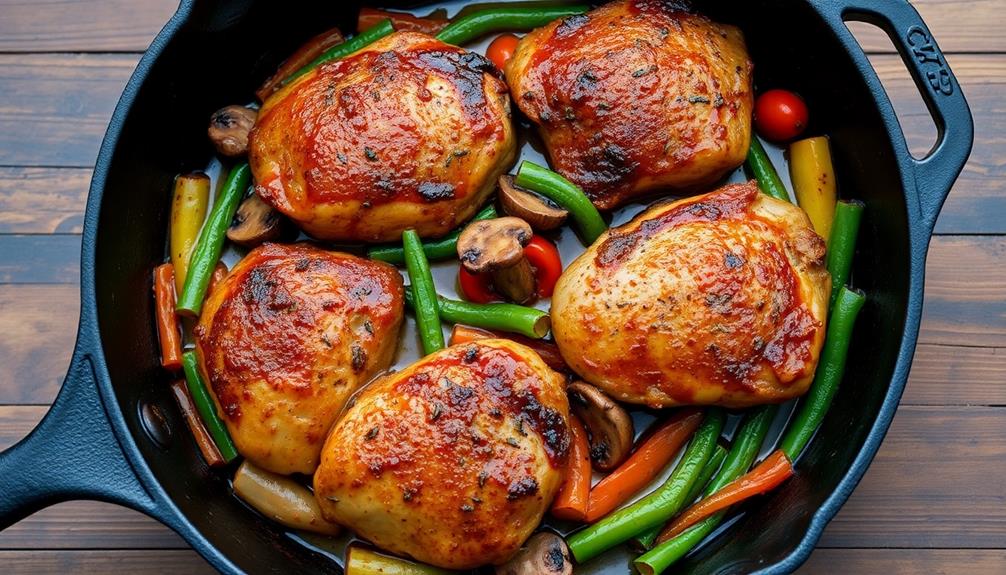To make digestible Moroccan harira, soak your legumes—like lentils and chickpeas—overnight in water with a bit of salt or lemon juice, which breaks down anti-nutrients and softens the structure. Proper soaking enhances water absorption, speeds cooking, and improves flavor integration. Rinse legumes well before adding them to your pot. Mastering this step guarantees your soup is both tasty and easy on your digestion. Keep exploring to discover more tips for perfecting your harira.
Key Takeaways
- Soaking lentils and chickpeas overnight softens their structure, improving digestibility and reducing cooking time.
- Using salt or lemon juice during soaking helps break down anti-nutrients, enhancing nutrient absorption.
- Proper drainage and rinsing after soaking remove residual anti-nutrients, making legumes easier to digest.
- Soaking promotes even water absorption, leading to better flavor integration and a smoother texture in Harira.
- Properly soaked legumes require less cooking time, preserving nutrients and preventing overcooking in the one-pot method.

If you’re looking for a hearty, flavorful soup that captures the essence of Moroccan cuisine, then one-pot Moroccan Harira is the perfect choice. This traditional dish combines a rich blend of spices and wholesome legumes, creating a comforting meal packed with flavor and nutrition. To achieve the authentic taste, mastering spice blending is essential. You’ll want to carefully measure and combine spices like cinnamon, ginger, turmeric, coriander, and pepper. These spices not only add complexity but also balance the earthy flavors of the legumes and tomatoes. When it comes to cooking techniques, browning the meat and vegetables upfront enhances the depth of flavor, creating a savory base for your soup. Sautéing onions and garlic until fragrant before adding spices allows the heat to release their aromatic oils, enriching the broth. Incorporating a touch of tomato paste early in the process helps to deepen the flavor profile and integrate the spices seamlessly.
A key aspect of making Harira is understanding how to prepare and soak your legumes, which directly impacts digestibility. Soaking lentils, chickpeas, and other legumes overnight softens their structure, making them easier to cook thoroughly and digest. Proper soaking also reduces cooking time and helps eliminate some of the compounds responsible for bloating or discomfort. When soaking, use plenty of water with a pinch of salt or a splash of lemon juice to improve legume tenderness. Drain and rinse the legumes before adding them to your pot, ensuring any residual anti-nutrients are washed away. This preparation step is vital because it allows the legumes to absorb water, swell, and break down their tough outer skins, making them more accessible for digestion and nutrient absorption. Understanding the science behind legume soaking can help optimize your cooking process for better digestibility and flavor. Additionally, employing soaking techniques that promote even water absorption can further enhance the nutritional benefits and reduce cooking time, making your Harira both healthy and flavorful. Incorporating knowledge of filtration systems can also assist in selecting legumes that are cleaner and more suitable for cooking.
Throughout the cooking process, employing the right techniques guarantees your Harira turns out perfectly every time. Simmer the soup gently to allow flavors to meld without breaking down the ingredients excessively. Keep the lid slightly ajar to prevent the soup from becoming too thick or over-reducing, which can concentrate flavors too intensely. As the legumes cook, you’ll notice their texture becoming tender and creamy, which is a sign they’re ready. Adding fresh herbs like cilantro or parsley near the end brightens the dish and keeps the flavors vibrant. The combination of proper spice blending and mindful cooking techniques makes your Harira not only delicious but also easier on digestion. By soaking legumes properly and paying attention to how you cook, you guarantee each bowl is both flavorful and gentle on your stomach, allowing you to enjoy the full richness of Moroccan cuisine with every spoonful.
Frequently Asked Questions
Can I Make Moroccan Harira Gluten-Free?
Yes, you can make Moroccan harira gluten-free by choosing gluten-free grains like rice, millet, or quinoa instead of traditional wheat. To prevent cross-contamination, use separate utensils and cookware designated for gluten-free cooking. Carefully check ingredient labels to verify no gluten is present. With these steps, you’ll enjoy a delicious, authentic harira that’s safe for gluten-sensitive or celiac diets.
How Long Does It Take to Soak Legumes Effectively?
Imagine you’re back in the days of dial-up internet; soaking legumes takes time, but it’s worth it. To soak effectively, plan for 8-12 hours at room temperature or slightly cooler. Use a non-reactive container like glass or ceramic. Soaking at warmer temperatures speeds up the process but risks fermentation. Adjust soaking time based on your legumes’ size and your schedule, ensuring they get tender and digestible.
Are There Vegetarian or Vegan Options for Harira?
You’ll find plenty of vegetarian and vegan options for harira, using plant-based substitutions like lentils, chickpeas, or tofu instead of meat. Cooking techniques such as simmering and blending help create a hearty, flavorful soup without animal products. You can add vegetables, spices, and herbs to enhance taste and texture, making it a satisfying, plant-based meal suitable for vegans and vegetarians alike.
What Are the Best Legumes for Digestibility?
You’re wondering which legume varieties are best for digestibility. Opt for lentils and split peas, as they naturally digest more easily and require shorter soaking times. Use effective soaking techniques, like rinsing thoroughly and soaking for 4-6 hours, to break down anti-nutrients and improve digestibility. Avoid larger beans like chickpeas or kidney beans unless you soak them properly, as they can cause digestive discomfort if not prepared correctly.
How Do Different Soaking Times Affect Flavor?
You’ll notice that soaking duration substantially impacts flavor enhancement in legumes. Shorter soaking times preserve a nuttier, more intense flavor, while longer durations mellow the taste and reduce bitterness. If you want a richer flavor, opt for a moderate soaking time, but if you prefer a milder, less beany taste, extend the soaking. Adjusting soaking duration allows you to customize flavor according to your preferences and recipe requirements.
Conclusion
Now that you’ve learned how soaking your legumes enhances digestibility, you’re better equipped to craft a delicious, nourishing harira. Remember, patience pays off—good things come to those who wait. By paying attention to these simple science-backed steps, you’ll enjoy a hearty bowl that’s gentle on your stomach and full of flavor. So go ahead, embrace the process, and cook with confidence—your taste buds and digestion will thank you for it.










